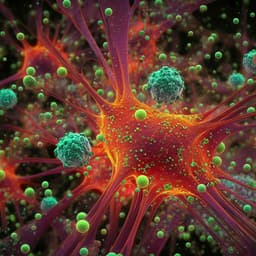
Medicine and Health
An Artificial Intelligence-guided signature reveals the shared host immune response in MIS-C and Kawasaki disease
P. Ghosh, G. D. Katkar, et al.
This compelling study reveals shared immunopathogenesis pathways between Multisystem inflammatory syndrome in children (MIS-C) and Kawasaki disease (KD), highlighting an IL15/IL15RA-centric cytokine storm. Conducted by a team of experts including Pradipta Ghosh and Jane C. Burns, it identifies unique targetable pathways in MIS-C and suggests it is more severe than KD, providing critical insights for clinical monitoring.
~3 min • Beginner • English
Introduction
MIS-C is a severe pediatric hyperinflammatory condition occurring 4–6 weeks after SARS-CoV-2 exposure, characterized by fever, mucocutaneous features, gastrointestinal symptoms, shock, and cardiac involvement. It shares overlapping features with Kawasaki disease (KD), an acute pediatric vasculitis and leading cause of acquired heart disease in children, whose triggers are thought to include diverse infectious and environmental stimuli modulated by host genetics. Distinguishing MIS-C from KD and other severe inflammatory conditions is challenging, and objective early diagnostic and prognostic markers are needed to guide care. Prior immunophenotyping studies suggested differences between MIS-C and KD, particularly in T-cell subsets and autoantibody profiles, but were limited by treatment confounders, lack of contemporaneous controls, absence of concurrent KD cohorts, and limited validation. The authors previously developed invariant host-response signatures to viral pandemics (ViP and sViP) capturing IL15/IL15RA-centric responses across pathogens, including COVID-19. Here, these signatures are applied to dissect shared and distinct features of MIS-C and KD, with the hypothesis that both syndromes engage a common host immune program with differing intensity and clinical expression.
Literature Review
Several studies compared MIS-C and KD immune profiles. Gruber et al. and Consiglio et al. reported MIS-C differs from KD in T-cell subsets; Vella et al. and Ramaswamy et al. showed skewed memory TCR repertoires and autoimmunity in severe MIS-C; Carter et al. found activation of CD4+CCR7+ and γδ T cells in MIS-C not reported in KD. Limitations included treatment exposure before sampling, lack of healthy pediatric controls during early pandemic, absence of side-by-side KD cohorts, and limited external validation. Prior work by Sahoo et al. defined a 166-gene ViP signature and a 20-gene sViP severity subset conserved across viral pandemics, distinct from classical ISGs, and centered on IL15/IL15RA pathways. A 13-transcript KD-specific whole-blood signature had been shown to distinguish KD from other febrile illnesses. The current study integrates these frameworks to reassess the MIS-C vs KD relationship and severity markers.
Methodology
- Study design and cohorts: Combined analysis of historic public KD datasets (microarrays/RNA-seq) and newly recruited, prospectively sampled cohorts of KD and MIS-C. KD cohorts included acute, subacute, and convalescent phases; MIS-C patients met CDC criteria, were sampled pre-treatment, and had anti–SARS-CoV-2 nucleocapsid IgG positivity with negative PCR in most cases. Febrile controls (pre-pandemic) were virologically diagnosed. Echocardiography and laboratory data were prospectively recorded. Ethical approvals and informed consent obtained (UCSD IRB).
- Samples and assays: Whole blood collected in PAXgene for RNA and serum for cytokines prior to treatments. RNA-seq libraries prepared (polyA or ribo/globin-depleted), sequenced on Illumina platforms (~30–50M paired-end reads). Serum cytokines quantified using MSD V-PLEX ultrasensitive assays (10 cytokine panel prioritized by relevance to KD/MIS-C). Formalin-fixed paraffin-embedded heart tissues (fatal KD) used for immunohistochemistry (IL15, IL15RA); lack of MIS-C heart tissue acknowledged.
- Computational signatures: Applied previously defined 166-gene ViP and 20-gene sViP signatures (computed via modified Z-score centered on StepMiner thresholds and summed per sample). Also applied the validated 13-transcript KD diagnostic signature. ROC-AUC used to assess classification (e.g., KD vs healthy, acute vs convalescent, responder vs non-responder).
- Bioinformatics and statistics: Data from GEO normalized (Affymetrix: RMA; RNA-seq: TPM, log2(TPM+1)); KD/MIS-C RNA-seq processed with salmon; batch correction via ComBat_seq. PCA (sklearn) and hierarchical agglomerative clustering (seaborn clustermap) on high MAD genes identified via StepMiner. Differential expression with DESeq2 (adjusted p<0.1, |log2FC|>0.5). Reactome pathway enrichment for DEGs. GSEA (MSigDB) guided by cytokines elevated on MSD (e.g., TNF, IFNγ, IL1β, IL10). Correlation analyses between signature scores, cytokines, and clinical labs (PLT, AEC, LVEF) using linear regression with significance testing (GraphPad Prism; Python seaborn).
- External validation: Applied sViP to independent MIS-C PBMC datasets (GSE166489, GSE167028) stratified by myocardial dysfunction/severity definitions. Broad evaluation of ViP/sViP and IL15/IL15RA composite across diverse immune states (immunosuppressed controls, infections, autoimmune diseases) using public datasets.
- Outcome measures: Ability of signatures to classify disease states (MIS-C vs KD vs controls), track phase (acute vs subacute/convalescent), correlate with severity indicators (giant CAAs in KD, myocardial dysfunction and reduced LVEF in MIS-C, thrombocytopenia, eosinopenia), and identify differential pathway activation (TNF, IFNγ, IL1β, IL10).
Key Findings
- ViP/sViP induced in KD: Across 7 independent historic KD cohorts, both ViP (166-gene) and sViP (20-gene) signatures were elevated in acute KD vs healthy (ROC AUC ~0.8–1.00) and decreased during convalescence (ROC AUC ~0.6–0.8 for ViP; 0.8–1.00 for sViP). sViP outperformed ViP consistently.
- Treatment-related patterns in KD: ViP/sViP did not predict IVIG response pre-treatment (ROC AUC ~0.5–0.6) but were reduced post-treatment in responders (ROC AUC ~0.8–0.9). In IVIG+methylprednisolone cohorts, both signatures decreased post-therapy and differentiated responders from non-responders (ROC AUC ~0.7–0.8).
- Severity tracking in KD: ViP/sViP differentiated acute KD with giant coronary artery aneurysms (CAA-giant) from convalescent KD (ROC AUC 0.95–0.97). ViP also separated CAA-giant from CAA− and CAA-small (p≈0.001–0.003); sViP separated CAA-giant from CAA− (p≈0.033).
- MIS-C vs KD continuum: In newly recruited cohorts, both ViP and sViP were significantly higher in MIS-C than acute KD when each compared to subacute KD controls, placing MIS-C farther along the host-response severity spectrum. Heatmaps highlighted IL15/IL15RA within ViP as central features in both conditions.
- KD-13 signature: The 13-transcript KD diagnostic signature did not distinguish KD from MIS-C in either historic or current cohorts, supporting molecular similarity between the syndromes.
- sViP identifies severe MIS-C: In GSE166489, sViP classified severe MIS-C (with myocardial dysfunction/ICU need) vs recovered/healthy (p=0.0173; ROC AUC ~0.96 for severe vs others). In GSE167028, a similar trend separated MYO+ vs MYO− MIS-C (ROC AUC ~0.75; p=0.0837).
- Cytokine profiling: Unsupervised clustering of 10-cytokine MSD panel separated acute KD/MIS-C from convalescent KD. Shared elevations in IL15, MIP1α, IL2, IL6, VEGF. MIS-C showed greater elevations in TNFα and IFNγ (significant), and trends for IL10, IL1β, IL8. GSEA corroborated higher TNF/NFκB and IFNγ pathway activation in MIS-C; IL1β- and IL10-related gene set changes were significant in pre-ranked analyses.
- Transcriptomic contrasts: DEGs between clustered MIS-C and KD samples showed MIS-C upregulation of interferon and cytokine signaling; downregulation of complement and phagocytosis pathways. Eleven ViP genes overlapped with MIS-C-upregulated DEGs; none overlapped with downregulated genes.
- Lab and clinical correlations: MIS-C had more severe cytopenias: lower WBC, ALC, AEC, PLT and higher CRP than KD (Table 1). Platelets (PLT) and absolute eosinophil counts (AEC) were both lower in MIS-C; PLT and AEC were positively correlated in MIS-C, and PLT negatively correlated with IL15 (both KD and MIS-C) and with MIP1α (MIS-C only). PLT and AEC negatively correlated with ViP, sViP, and IL15/IL15RA composite in MIS-C; in KD, only PLT showed such correlations.
- Cardiac phenotypes: LVEF was significantly reduced in MIS-C vs KD (p=0.006). sViP scores correlated with reduced LVEF in MIS-C (p=0.023), whereas ViP and IL15/IL15RA composite did not. In KD, IL15/IL15RA composite scores distinguished KD with giant CAAs from convalescent controls (ROC AUC up to 0.95). Immunohistochemistry in a fatal KD heart showed IL15 and IL15RA expression in cardiomyocytes and coronary arterioles with fibrosis.
- Broader disease context: ViP/sViP were not induced in immunosuppressed states (malignancy, pregnancy, post-transplant) but were induced in infections (sepsis, HIV, RSV, TB) and in some autoimmune diseases with infectious links (e.g., SLE, JIA, IBD); many shared IL15/IL15RA-centric responses.
- Therapeutic implications: Enhanced TNF and IL1 pathways in MIS-C suggest potential benefit of FDA-approved inhibitors (infliximab, anakinra). Emerging clinical reports support infliximab efficacy in MIS-C.
Discussion
The study demonstrates that MIS-C and KD share a fundamental, invariant host immune response program also seen in COVID-19, centered on IL15/IL15RA signaling. Application of ViP/sViP signatures objectively places MIS-C and KD on a common continuum, with MIS-C exhibiting a more intense immune activation. While both syndromes converge on IL15/IL15RA-driven cytokine storm, they diverge in clinical expression: MIS-C is characterized by more profound thrombocytopenia, eosinopenia, and impaired myocardial contractility; KD is defined by systemic vasculitis with risk for coronary artery aneurysms. The sViP signature tracks distinct forms of severity across diseases: myocardial dysfunction in MIS-C, giant CAAs in KD, and poor outcomes in adult COVID-19. Integration of cytokine and transcriptome data reveals that TNF/NFκB and IFNγ pathways are more strongly activated in MIS-C, suggesting targetable axes. Correlative analyses link higher ViP/sViP and IL15/IL15RA composite scores with thrombocytopenia and eosinopenia in MIS-C, providing candidate biomarkers to monitor severity and guide care. The inability of the KD-13 signature to distinguish KD from MIS-C supports their molecular relatedness despite distinct clinical phenotypes. The results align with prior proteomic clustering that grouped KD and MIS-C, strengthening the concept of shared proximal immunopathogenesis with disease-specific distal pathways and organ targeting.
Conclusion
This work shows that KD, MIS-C, and COVID-19 represent distinct clinical states along a shared host immune response continuum marked by IL15/IL15RA-centric activation. ViP and sViP signatures, developed in the context of viral pandemics, generalize to pediatric hyperinflammatory syndromes, quantifying disease intensity and identifying severity phenotypes: sViP correlates with myocardial dysfunction in MIS-C and with coronary aneurysm risk in KD. MIS-C exhibits stronger activation of TNF and IFNγ pathways and distinctive laboratory features (thrombocytopenia, eosinopenia) that correlate with ViP/sViP and IL15/IL15RA scores. These insights suggest rational therapeutic strategies targeting TNFα and IL1β (e.g., infliximab, anakinra) and highlight simple, trackable clinical markers (PLT, AEC, LVEF) for risk monitoring. Future studies should validate these signatures in larger, multi-center MIS-C cohorts, incorporate longitudinal sampling to track dynamics across disease phases and treatments, and investigate tissue sources and consequences of IL15/IL15RA expression, particularly in cardiac tissues in MIS-C.
Limitations
Key limitations include a relatively small MIS-C sample size (n≈10–12) in the prospective cohorts and limited publicly available MIS-C datasets for independent validation; lack of MIS-C cardiac tissue and only a single fatal KD heart for immunohistochemistry, limiting generalizability of tissue-level findings; potential heterogeneity in MIS-C severity definitions across external datasets; and the observational nature of cytokine/transcript correlations without mechanistic proof. While batch correction and standardized pipelines were applied, cross-platform and cohort variability may influence effect estimates.
Related Publications
Explore these studies to deepen your understanding of the subject.







